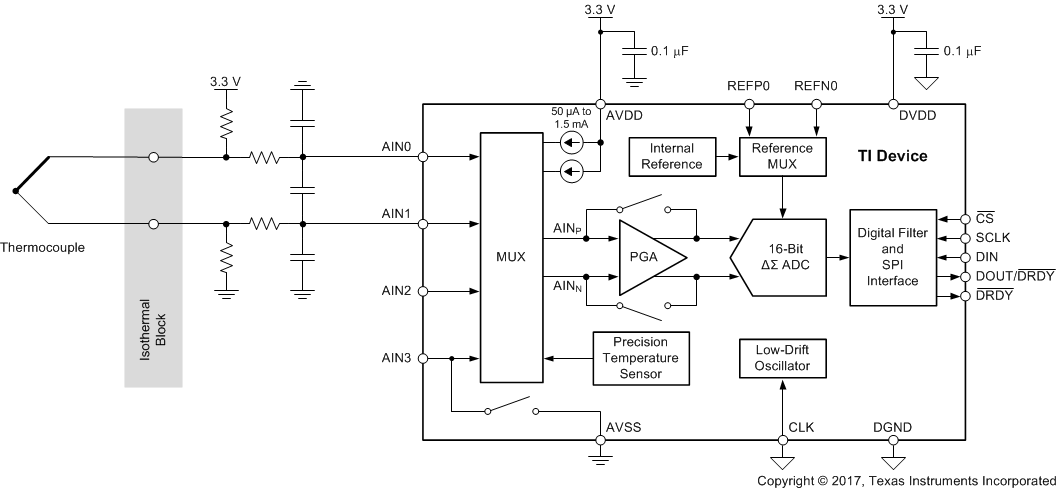ZHCSDB9C August 2013 – February 2017 ADS1120
PRODUCTION DATA.
- 1 特性
- 2 应用
- 3 说明
- 4 修订历史记录
- 5 Pin Configuration and Functions
- 6 Specifications
- 7 Parameter Measurement Information
-
8 Detailed Description
- 8.1 Overview
- 8.2 Functional Block Diagram
- 8.3 Feature Description
- 8.4 Device Functional Modes
- 8.5 Programming
- 8.6 Register Map
- 9 Application and Implementation
- 10Power Supply Recommendations
- 11Layout
- 12器件和文档支持
- 13机械、封装和可订购信息
1 特性
- 低电流消耗:
占空比模式下低至 120μA(典型值) - 宽电源范围:2.3V 至 5.5V
- 可编程增益:1V/V 至 128V/V
- 可编程数据速率:高达 2kSPS
- 16 位无噪声分辨率(20SPS 时)
- 采用单周期稳定数字滤波器,在 20SPS 时
实现 50Hz 和 60Hz 谐波抑制 - 两个差分输入或四个单端输入
- 双匹配可编程电流源:50μA 至 1.5mA
- 内部 2.048V 基准电压:漂移 5ppm/°C(典型值)
- 集成 2% 精准振荡器
- 集成温度传感器:精度 0.5°C(典型值)
- 与 SPI 兼容的接口(模式 1)
- 封装:3.5mm × 3.5mm × 0.9mm 超薄型四方扁平无引线 (VQFN)
2 应用
- 温度传感器测量:
- 热敏电阻
- 热电偶
- 电阻式温度检测器 (RTD):
2 线、3 线或 4 线制类型
- 电阻桥式传感器测量:
- 压力传感器
- 应力计
- 衡器
- 便携式仪表
- 工厂自动化和过程控制
3 说明
ADS1120 是一款 16 位高精度模数转换器 (ADC),集成了多种 特性, 能够降低系统成本并减少小型传感器信号测量 应用 中的组件数量。该器件 具有 通过输入多路复用器 (MUX) 实现的两个差分输入或四个单端输入,一个低噪声可编程增益放大器 (PGA),两个可编程激励电流源,一个电压基准,一个振荡器,一个低侧开关和一个精密温度传感器。
此器件能够以高达 2000 次/秒 (SPS) 采样数据速率执行转换,并且能够在单周期内稳定。针对噪声环境中的工业应用,当采样频率为 20SPS 时,数字滤波器可同时提供 50Hz 和 60Hz 抑制。内部 PGA 提供高达 128V/V 的增益。此 PGA 使得 ADS1120 非常适用于小型传感器信号测量 应用 ,例如电阻式温度检测器 (RTD)、热电偶、热敏电阻和桥式传感器。该器件在使用 PGA 时支持测量伪差分或全差分信号。此外,该器件还可配置为禁用内部 PGA,同时仍提供高输入阻抗和高达 4V/V 的增益,从而实现单端测量。
在禁用 PGA 后的占空比模式下运行功耗可低至 120µA。ADS1120 采用无引线 VQFN-16 或薄型小外形尺寸 (TSSOP)-16 封装,额定工作温度范围为 -40°C 至 +125°C。
器件信息(1)
| 器件型号 | 封装 | 封装尺寸(标称值) |
|---|---|---|
| ADS1120 | VQFN (16) | 3.50mm x 3.50mm |
| TSSOP (16) | 5.00mm x 4.40mm |
- 如需了解所有可用封装,请见数据表末尾的可订购米6体育平台手机版_好二三四附录。
